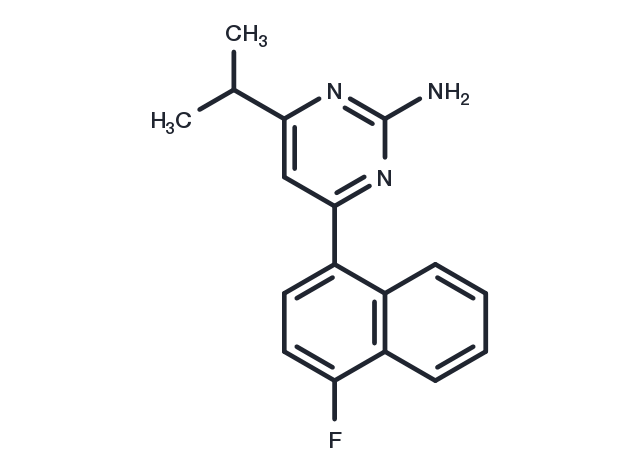Powder: -20°C for 3 years | In solvent: -80°C for 1 year


RS-127445 (MT500) is a selective 5-HT2B receptor antagonist with pKi of 9.5 and pIC50 of 10.4, exhibits <1000-fold selectivity against other 5-HT receptors.

| Pack Size | Availability | Price/USD | Quantity |
|---|---|---|---|
| 2 mg | In stock | $ 40.00 | |
| 5 mg | In stock | $ 50.00 | |
| 10 mg | In stock | $ 80.00 | |
| 25 mg | In stock | $ 171.00 | |
| 50 mg | In stock | $ 293.00 | |
| 100 mg | In stock | $ 561.00 | |
| 1 mL * 10 mM (in DMSO) | In stock | $ 54.00 |


| Description | RS-127445 (MT500) is a selective 5-HT2B receptor antagonist with pKi of 9.5 and pIC50 of 10.4, exhibits >1000-fold selectivity against other 5-HT receptors. |
| Targets&IC50 | 5-HT2B:9.5(pKi), 5-HT2B:10.4(pIC50) |
| In vitro | RS-127445 is a novel high affinity, selective 5-HT2B receptor antagonist devoid of detectable intrinsic activity. RS-127445 is found to have nM affinity and 1000 fold selectivity for the 5-HT2B receptor. RS-127445 is thus among the highest affinity, most selective 5- HT2B receptor ligands. RS-127445 potently blocks the 5-HT evoked increase in inositol phosphate formation and blocks the 5-HT evoked increases in intracellular calcium concentrations with a potency 1000 times greater than that of yohimbine. [1] |
| In vivo | RS-127445 is readily absorbed with no obvious dose or route-dependent limitations and rapidly absorbed following both oral and intraperitoneal administration with peak plasma concentrations being achieved within 15 min of dosing. RS-127445 concentration in the plasma are proportional to the administered dose. RS-127445 administrated at dose of 5 mg/kg with approximately 60% of an intraperitoneal dose and 14% of the oral dose is bioavailable. RS-127445 concentration in the plasma is predicted to fully saturate accessible 5-HT2B receptors can be readily achieved and maintained in the rat. RS-127445 administered at 1 to 10 mg/kg with oral significantly inhibits visceral hypersensitivity up to 35 to 74% provoked by restraint stress. Oral RS-127445 produces a significant suppression of TNBS-induced visceral hypersensitivity (15 to 62% inhibition at 3 to 30 mg/ kg), although RS-127445 has no significant effect on the visceral nociceptive threshold of native rats. RS-127445 administrated orally with 1 to 30 mg/kg also dose -dependently reduce the restraint stress-induced defecation in native and TNBS-treated rats. [2]. RS-127445 inhibits colonic motility and defecation. [3] |
| Kinase Assay | Radioligand binding: The selectivity of RS-127445 for 5-HT2B receptors is examined by testing the compound for affinity at over 100 additional ion channel or receptor binding sites. CHO-K1 cells expressing human 5-HT2A, 5-HT2B or 5-HT2C receptors are harvested using 2 mM EDTA in phosphate buffered saline. Cell membranes are prepared by four cycles of homogenization and centrifugation (48,000×g for 15 min). Each assay is established so as to achieve steady state conditions and to optimize specific binding. For the 5-HT2A receptor, membranes from 1×106 cells are incubated with 0.2 nM [3 H]-ketanserin at 32 °C for 60 min. Nonspecific binding is determined using 10 μM methysergide. For the 5-HT2B receptor, membranes from 1.5×106 cells are incubated with 0.2 nM [3 H]-5-HT at 48 °C for 120 min. Nonspecific binding is determined using 10 μM 5-HT. For the 5-HT2Creceptor, membranes from 3×10 5 cells are incubated with 0.5 nM [3 H]-mesuler -gine at 32 °C for 60 min. Nonspecific binding is determined using 10 μM methysergide. Assays are terminated by vacuum filtration through glass fibre filters(GF/B) which has been pretreated with 0.1% polyethyleneimine. Total and bound radioactivity is determined by liquid scintillation counting. Greater than 90% specific binding is achieved in each of these assays. |
| Cell Research | RS-127445, vehicle or other antagonists are pre-incubated with 240 μl of HEK-293 cells expressing the human 5-HT2B receptor suspension at 37 °C for 20 min. HEK-293 cells are incubated with[3H]-myoinositol (1.67 μCi/ml) in 162 cm2 flasks overnight at 37 °C in an inositol free Ham's F12 medium containing 10% dialyzed foetal bovine serum. The cells are harvested, washed five times with phosphate bufffered saline and resuspended in inositol free Ham's F12 media at density of approximately 3×103 cells/ml. The reactions are initiated by addition of 5-HT. Sixty minutes later, the reactions are terminated by adding 50 μl of ice-cold 20% perchloric acid, chilled in an ice-water bath for 10 min and then neutralized with 160μl of 1 N KOH. Each sample is diluted with 2 ml of 50 mM Tris-HCl, pH 7.4 at room temperature. The aqueous portion (2.2 ml) is transferred onto Dowex AG1X8 columns (1 ml, 1 : 1, w/v) which has been washed with 5 ml of distilled water. The columns are then washed with 18 ml of distilled water and the inositol phosphates are eluted with 3 ml of 1 N HCl. The eluted radioactivity is determined by liquid scintillation spectroscopy using a Packard 1900CA analyzer. [1] (Only for Reference) |
| Synonyms | MT500 |
| Molecular Weight | 281.33 |
| Formula | C17H16FN3 |
| CAS No. | 199864-87-4 |
Powder: -20°C for 3 years | In solvent: -80°C for 1 year
Ethanol: 8 mg/mL (28.43 mM)
DMSO: 52 mg/mL (184.8 mM)
H2O: < 1 mg/mL (insoluble or slightly soluble)
You can also refer to dose conversion for different animals. More
bottom
Please see Inhibitor Handling Instructions for more frequently ask questions. Topics include: how to prepare stock solutions, how to store products, and cautions on cell-based assays & animal experiments, etc.
RS-127445 199864-87-4 GPCR/G Protein Neuroscience 5-HT Receptor MT 500 inhibit Inhibitor MT-500 MT500 Serotonin Receptor RS127445 RS 127445 5-hydroxytryptamine Receptor inhibitor
